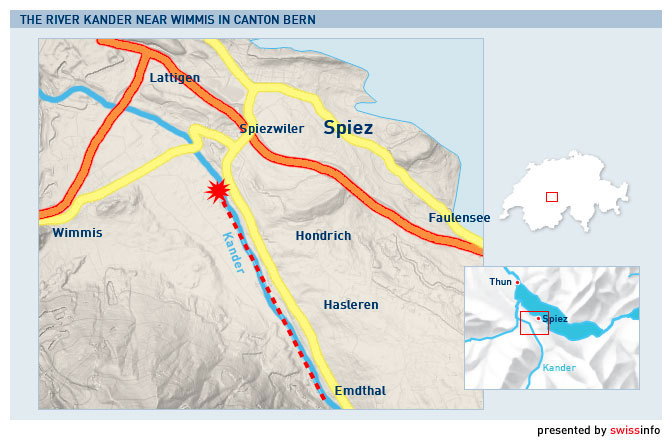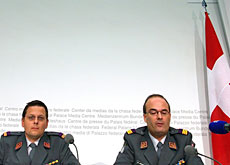Search goes on for missing soldiers

Rescuers are still looking for two soldiers who went missing after a boating incident on the River Kander near Wimmis on Thursday that left three others dead.
The reasons behind the accident in the Bernese Oberland, and why the ten men undertook what is considered a dangerous exercise, still remain unclear as the search goes on.
Over 100 troops, rescue specialists and military police were looking for the missing soldiers on Friday. But air force commander Walter Knutti warned at a news conference in Spiez that there was little hope that the men would be found alive.
Operations have been hindered by the river’s fast-flowing and murky water, according to Peter Luttenbacher of the Lake Thun water police. Conditions are particularly dangerous in some areas, ruling out the use of divers.
The two rubber boats that collided on Thursday while carrying ten men from an airfield security unit have been recovered. A military investigating judge is now attempting to determine the exact circumstances of the accident.
The army has so far been unable to say whether the two boats were designed for the type of exercise that was undertaken, or if soldiers had already travelled down the Kander this way before. It is also unclear if the men involved had the necessary knowhow for the exercise they were carrying out.
Army chief Roland Nef has already warned that the investigation will take some time. “We are doing everything in our power to ensure that the causes of this catastrophe are properly examined by our military justice,” he added in a news release.
Dangerous
The stretch of the river where the accident happened is considered by canoe and rafting specialists as dangerous, especially because of the weirs used to slow the water flow and the currents they generate.
“Weirs, artificial dams built across the river to slow down the current if there is flooding, are taboo in white water circles,” Daniel Chezière, head of swissraft, told swissinfo.
“It’s the first thing you learn when you start kayaking and you are allowed to head out on the river: stay away from weirs.”
For Chezière, the water at the bottom of a weir is like a washing machine. “When you are in it, there’s no way out,” he added.
But he refuses to blame army material for the lost lives.
“There is nothing available that can handle that type of impact,” he pointed out. “Just like there no cars that can handle a frontal collision at over 80 kilometres per hour.”
Chezière says that ignorance is probably what led to the tragedy.
“It seems obvious that there was no one on those boats who knew what white water is. If there was a so-called expert with them, then our soldiers really have something to worry about,” he added.

More
Militia army
Criticism
There has been some criticism from within the ranks of the army. Denis Froidevaux, vice-president of the officers’ association, said the precaution principle had obviously been ignored.
“The golden rule is to limit the risk factor as much as one can,” he added.
Nef reminded his officers on Friday to consider all the risks before undertaking an exercise. But he also pointed out that in the army no exercise was 100 per cent safe.
Earlier in the day he travelled to the site of the Wimmis tragedy and visited the five injured survivors in hospital. Four of them were able to check out later.
The accident happened during what was apparently a team-building exercise. The soldiers were all officers and non-commissioned officers from German-speaking Switzerland, aged between 25 and 33.
A memorial service for the victims is planned for next week in Thun.
swissinfo with agencies
July 12, 2007: six recruits die in an avalanche on the Jungfrau in the Bernese Oberland, the worst accident in 15 years for the armed forces.
October 12, 2001: an Alouette III helicopter hits a cable near Crans-Montana in canton Valais and crashes, killing all four people on board.
May 25, 2001: an Alouette III helicopter hits a cable near Delémont in canton Jura, killing the pilot and three border guards.
November 12, 1997: a Pilatus Turbo-Porter aircraft crashes during an exercise near Simmental in canton Bern. The pilot and four passengers die.
June 22, 1994: a civilian helicopter collides with a Swiss army Super Puma helicopter and crashes. A British couple and the pilot are killed.
April 27,1993: an army Pilatus Porter is caught up in high winds and flies into a cliff on the Finsteraarhorn in canton Bern. Three people die.
November 2, 1992: six people die when a munitions depot blows up near Susten in canton Bern.


In compliance with the JTI standards
More: SWI swissinfo.ch certified by the Journalism Trust Initiative










You can find an overview of ongoing debates with our journalists here . Please join us!
If you want to start a conversation about a topic raised in this article or want to report factual errors, email us at english@swissinfo.ch.